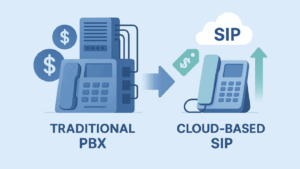Telephony Terms to Know
![]() We’ve often said that you don’t have to be a telephony expert to enjoy the cost savings and flexibility of SIP trunking. That is absolutely true, but it does help if you are at least somewhat familiar with the most commonly used telephony terms and acronyms. Once you know what these terms mean, a lot of the stuff you hear from service providers like us will make a lot more sense. Here are a few of the ones you’ll encounter most often.
We’ve often said that you don’t have to be a telephony expert to enjoy the cost savings and flexibility of SIP trunking. That is absolutely true, but it does help if you are at least somewhat familiar with the most commonly used telephony terms and acronyms. Once you know what these terms mean, a lot of the stuff you hear from service providers like us will make a lot more sense. Here are a few of the ones you’ll encounter most often.
ATA (Analog Telephone Adaptor)
An ATA is a small, inexpensive device that translates digital signals to analog. It is used to connect PBX systems that are not internet enabled to SIP services. It can also be used to connect fax machines, alarm systems, door buzzers, and overhead paging systems.
Bandwidth
Bandwidth is the amount of data that can be transmitted over a communication line in a fixed amount of time. It is measured in bits per second (bps) or bytes per second for digital devices and in cycles per second, or Hertz (Hz) for analog devices.
Broadband Telephony
Broadband telephony refers to a communications protocol for transmitting telephone calls over an internet network. The term is used interchangeably with IP telephony, Internet telephony, and broadband telephone service.
E911
E911 is an abbreviation of Enhanced 911. Also called “Nomadic” e911 this service allows customers to set any physical address in the US as the address to be transmitted to the Public Safety Answering Point when a call is made to 911. This is essential for making sure that emergency resources can respond quickly to the correct address.
IP (Internet Protocol)
IP is the set of rules that govern the way data is moved between devices on a network. It is part of the TCP/IP communications protocol suite. Telephony devices that are designed to be used over the internet are said to be “IP enabled.” IP enabled telephones may also be referred to as “SIP Phones” or “VoIP Phones.”
Jitter
In telephony, jitter refers to a fluctuation in the transmission signal. This can occur when a data packet arrives ahead or behind a standard clock cycle. Jitter results in poor audio quality.
Latency
Latency is the time between the transmission of a voice packet and when it reaches its destination. Latency is used to judge the efficiency and quality of networks. It is also referred to as “Lag.” Along with Jitter, latency is a problem that can impact the experience of callers.
PBX (Private Branch Exchange)
A PBX consists of the hardware and software that make up a business telephone system. When a PBX is internet enabled and used over a data network, it is called an Internet PBX or an IP PBX.
POTS (Plain Old Telephone Service)
A POTS line is a single line and a single phone number. If your home phone is wired, it is a POTS line. Dedicated fax lines are an example of how POTS lines are used in business.
PRI (Primary Rate Interface)
PRI is a physical connection to the PSTN over a dedicated line that only serves voice transmission. Legacy business telephone systems leverage PRI. SIP trunking is an alternative to PRI lines.
PSTN (Public Switched Telephone Network)
The PSTN is the combination of local, long-distance, and international carriers that make up the worldwide telephone network. In SIP trunking, calls are delivered to the PSTN over the internet.
QoS (Quality of Service)
QoS is a router setting that prioritizes voice traffic over data traffic. This setting is important in SIP trunking because it eliminates voice quality problems that can result from competing voice and data traffic.
SIP (Session Initiation Protocol)
Session Initiation Protocol (SIP) is a telephony protocol used for conducting multi-media communication like voice and video calls using internet networks. It controls messages that are sent between various devices on the network and manages establishment, termination and other elements of the call.
SIP Channel
A SIP channel represents one connection to the PSTN. SIP trunks can have an unlimited number of channels, with each channel representing one concurrent telephone call. SIP is typically sold by the single channel, unlike PRI lines, which are sold in blocks of 23.
VoIP (Voice over IP)
Voice over Internet Protocol (VoIP) is a group of technologies that work to deliver voice and other multimedia sessions over Internet Protocol (IP) networks, most commonly the Internet. Although the terms VoIP and SIP are often used interchangeably, SIP is actually a subset of VoIP. Other ways of achieving VoIP include the public internet and private point-to-point networks.
This list isn’t exhaustive, but it covers the key terms that you really need to know to make sense out of what you read about telephony. We hope you find it helpful.


